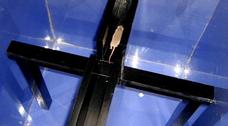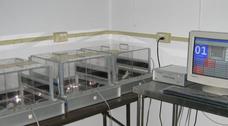Elevated Plus Maze
The elevated plus maze has become the "gold standard" test for assessing anxiety in the rodent. It has also been shown to be sensitive to both traditional and novel anxiolytics. The test creates an approach-avoidance conflict between the natural tendency of the rodent to explore and its aversion for open spaces (which helps prevent detection from predators). The elevated plus maze itself consists of two enclosed arms and two open arms (i.e. arms without walls). Anxiety is typically measured by the amount of time the animal explores the open arms. The more anxious the animal, the less it will explore the open arms. In addition, the test has recently been adapted to include ethological measures of “risk assessment” (e.g., stretch-attend postures) that have been shown to be sensitive to serotonergic-based anxiolytics.
Open Field
This test measures exploratory behaviour in a novel, enclosed environment. Whereas its primary use is to assess locomotor function, the test can also be used to assess anxiety, as measured by the amount of time the animal avoids the exposed Centre area of the field, and remains in close proximity to the walls. The degree of stress can be experimentally manipulated in a variety of ways, by changing the color of the enclosure (e.g., white is more stressful then black), by increasing its size, or by varying the intensity of the overhead lights.
Novelty-Suppressed Feeding (Thatcher-Britton)
This test was originally developed to provide a more sensitive behavioural correlate of hypothalamic-pituitary-adrenal (HPA) axis activity. It is similar to the open field, but the approach-avoidance conflict is strengthened by food-depriving the animal for 24 hours, prior to placing the animal in the open field with food located directly in the middle of the enclosure. A more anxious animal will take more time before starting to eat.
Fear Potentiated Startle
This is one of a number of paradigms that can be used to assess the strength of discrete conditioned stimulus (CS) fear conditioning. Animals are first trained to associate a CS (a light) with an aversive unconditioned stimulus (a shock). Following fear conditioning, the light is presented in conjunction with an unexpected (unpredictable) acoustic stimulus that elicits a startle response. The magnitude of the CS/startle response is contrasted with that induced by presentation of the acoustic startle stimulus alone. The more anxious the animal, the greater the CS/Startle response is in contrast to the startle response observed in the absence of the CS. Note: Whereas fear potentiated startle is a reliable and robust phenomenon in the rat, there is little evidence that mice will display this phenomenon.
Defensive Burying
This test exploits the rats' innate tendency to bury offensive stimuli it may encounter. For instance, rats have been observed to kick dirt at approaching predators such as a snake. In the defensive burying test, animals are placed into an arena containing a shock-probe. When the animal explores and makes contact with the probe, it receives a shock. If bedding is present in the arena, the animal will use it to bury the probe; the greater the amount of time and/or the greater the height of the bedding material, the more anxious the animal.
Marble Burying
Rodents - mice in particular - will bury novel objects that they perceive to be potentially dangerous. Thus, mice will bury novel marbles when placed into an arena with sufficient bedding. This behaviour is attenuated by standard and novel anxiolytics, hence the inference that this behaviour is (at least in part) motivated by anxiety. The primary dependent measure is the number of marbles buried; the greater the number, the greater the presumed anxiety state of the animal.
Light Dark Test
In this test animals are allowed to explore an arena consisting of a bright and a dark compartment. Rodents are generally averse to brightly-lit areas, the more anxious the animal, the more this aversion results in exploration restricted to the dark compartment.




